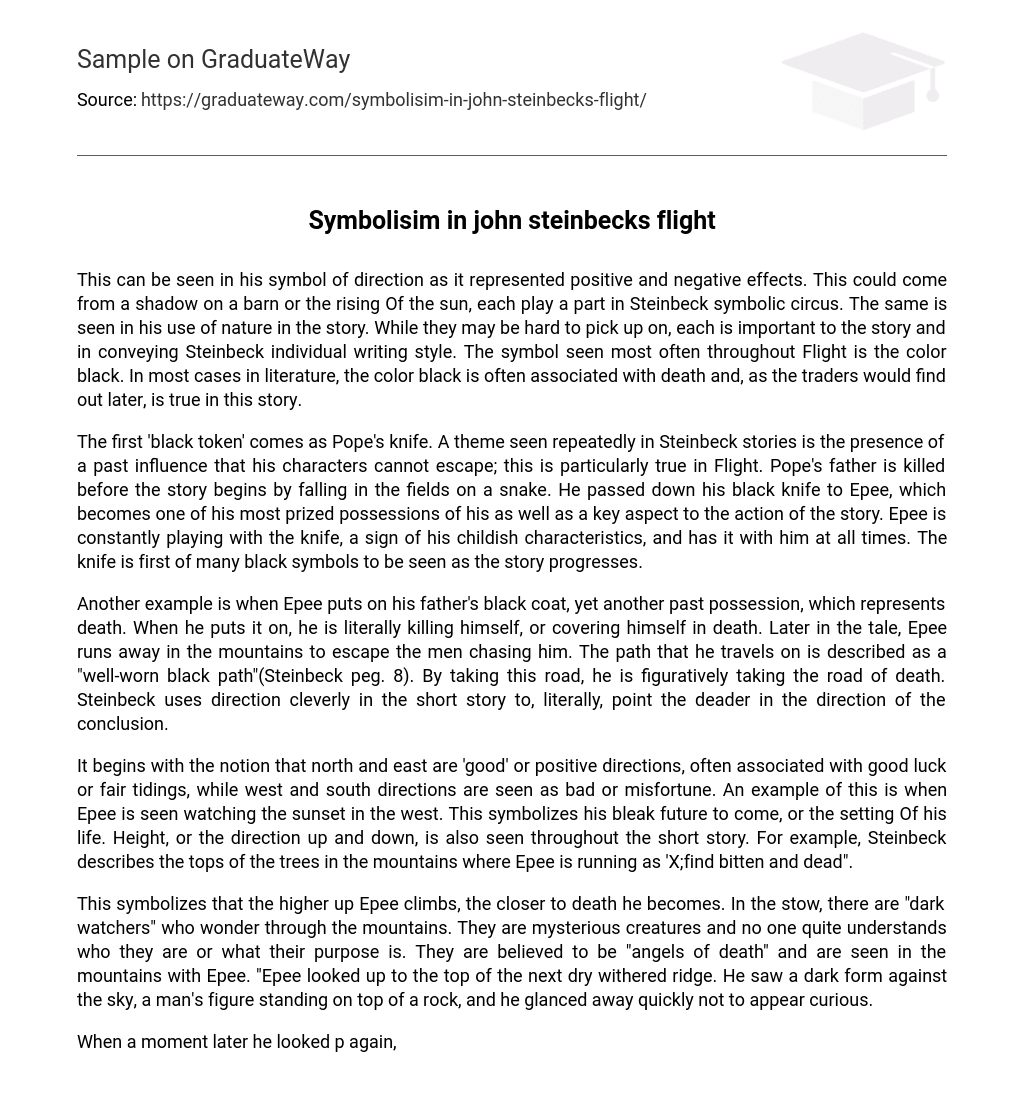Steinbeck’s use of symbolism is evident in his representation of positive and negative effects through his symbol of direction. This symbolism can be observed in various aspects such as a shadow on a barn or the rising of the sun, all of which contribute to the symbolic circus created by Steinbeck. Additionally, nature is also utilized by the author to convey his unique writing style, albeit subtly. One recurring symbol in the story “Flight” is the color black, which in literature is often associated with death. As the traders later discover, this association holds true in the story.
One recurring theme in Steinbeck stories is the inescapable influence of the past on his characters. This is especially evident in Flight, where the first manifestation of this influence is Pope’s knife. Before the story begins, Pope’s father dies after being bitten by a snake while working in the fields. He passes down his black knife to Epee, who cherishes it immensely and carries it with him constantly. Epee frequently plays with the knife, demonstrating his childlike nature. As the story unfolds, the knife is just the first of many black symbols that emerge.
In another instance, Epee adorns his late father’s black coat, symbolizing death as yet another object from the past. When he puts it on, it is as if he is metaphorically causing his own demise or enveloping himself in death. Later on in the narrative, Epee flees from his pursuers and seeks refuge in the mountains. The path he chooses to take is described as a “well-worn black path” (Steinbeck peg. 8). By selecting this particular route, he is symbolically opting for the path of death. Steinbeck skillfully utilizes direction in the short story to literalize and guide the reader toward the conclusion.
North and east are typically considered positive directions, associated with good luck and favorable circumstances, whereas west and south are considered negative directions symbolizing misfortune. In John Steinbeck’s short story, this notion is reflected when Epee is observed watching the sunset in the west, symbolizing the bleak future awaiting him. Additionally, the concept of height or verticality is evident throughout the narrative. Steinbeck depicts the trees atop the mountains where Epee is fleeing as “wind-bitten and lifeless”.
This symbolizes the increasing proximity to death as Epee ascends higher. In the mountains, there are mysterious creatures known as “dark watchers” who roam around. Their identity and purpose remain unknown. However, they are believed to be associated with death and are frequently seen alongside Epee in the mountains. As Epee gazed at the summit of the next arid ridge, he noticed a dark silhouette of a man standing on a rock against the backdrop of the sky. To avoid appearing too inquisitive, he promptly looked away.
Steinbeck utilizes the dark watchers as symbols of mortality, including Pope’s impending death, rather than as a means to drive the plot forward. By positioning them atop a hill, which is often associated with death in this narrative, Steinbeck underscores their significance. The story predominantly takes place in the mountains, with nature playing a pivotal role in the storyline. Similarly, in Flight, Steinbeck employs water as a representation of life, exemplified by Pope’s water bag that was suspended over his horse’s shoulder throughout the journey.
As the water drained away, so did his life, an idea supported by later events in the story where his horse is shot in the same shoulder where the bag had been. This theme is further exemplified as Epee ventures deeper into the mountains, initially staying close to the river but gradually drifting further away. This symbolizes the gradual depletion of his life force, as depicted on page nine when Steinbeck writes, “His throat was almost closed with thirst. At first he tried to run, but immediately he fell and rolled.” Moving up the mountain signifies Epee’s approaching death and his growing weakness. Despite being shot and unable to stand, he crawls up the mountain face resembling a snake, subtly connecting him to the past influences that also killed his father. To foreshadow the tragic yet thought-provoking ending, Steinbeck incorporates numerous symbols in Might, some overt and others more inconspicuous.





